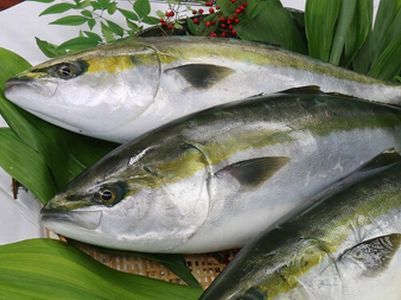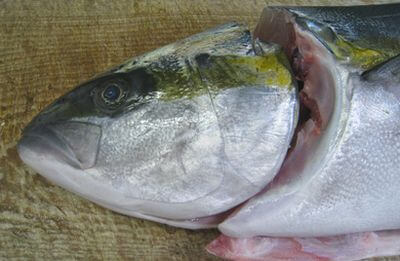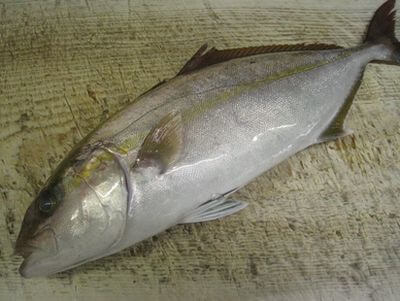 In the United States and other countries, “Buri: right image” is called yellowtail, but this word refers to fish like “buri” and “hiramasa” and actually can be applied to a large number of fish. Actually, it isn’t far off since a layman can’t tell the difference between a “buri” and “hiramasa” just by the pretty yellow line on the side of the fish’s body.
In the United States and other countries, “Buri: right image” is called yellowtail, but this word refers to fish like “buri” and “hiramasa” and actually can be applied to a large number of fish. Actually, it isn’t far off since a layman can’t tell the difference between a “buri” and “hiramasa” just by the pretty yellow line on the side of the fish’s body.
In Japan, “buri” is the most well-known fish that goes by different names depending on its stage in life (shusse fish). Actually “buri” has many different names even depending on the region you are in. For example, in the Kanto region, it may be called wakashi (0 to 30 cm) → Inada (30 to 60 cm) → Warasa (60 to 80 cm) → Buri (80 cm or more), and from Kansai on further west, it is called, Tsubasu (0 to 30 cm) → Hamachi (30 to 60 cm)→ Mejiro (60 to 80 cm) or Buri (80 cm or more).
This is where the term “hamachi” came from West of Kansai, full-grown buri, at about 30 to 60 cm is called Hamachi. In other words, Hamachi is a young buri.
Of course, it’s not that simple. You can get hamachi sashimi at grocery stores all over Japan, all year long. Hamachi is not only used from Kansai westward, it is also used at grocery stores throughout Japan. This may lead you to believe that hamachi is a different fish and not the same as buri, but you would be mistaken.
Behind the curtain, buri cultivation is thriving in Japan (and throughout the world). More than 80% of the buri on the market is said to be farmed. Because it is not apparent by appearance whether the buri was raised in the wild or by aquaculture, the wild-raised fish is called buri by market affiliates in order to make it easier to understand. That means farmed products have come to be called hamachi.
Also, in the Setouchi region, people preferred to eat the young hamachi rather than the adult buri. Kagawa Prefecture became the first in the world to successfully cultivate hamachi in 1928, and that is what led ‘hamachi’ to become synonymous with ‘farmed fish’. Of course, that would be one reason that people call farmed buri, hamachi.
What is the difference in taste between wild buri and farmed hamachi?
Buri (yellowtail) is a fish for which the name changes according to the stage of growth. We would like to start this article by reviewing the definition of “hamachi”.
Jumping right into it, medium-sized (30-60 cm), farmed “inada” or “wakashi” class buri is called “hamachi”. Even in Kanto, the names inada and wakashi are only used for wild fish, while hamachi is used for farmed fish.
The accepted theory is that the delicious flavor of Kanburi (wild buri caught during the cold months of November to February that has grown fat for the winter) depends heavily on the condition of high-fat content. The two major brands of Kanburi are caught on the Noto Peninsula and Himi in the Hokuriku region, and buri caught in Hokuriku has a higher fat content and also tastes better than buri caught in other places. This may be because fish that live in the frigid sea have higher fat content than those that live in warm seawaters.
You don’t know the true taste of buri until you’ve had Kanburi. It is especially popular as sashimi. The fat of the buri enters the muscle tissue, turning the fat into an incredible texture that practically melts in your mouth. Whether farmed or wild, the lipid content reaches its peak from December to January. This is 10% lipid content in the wild fish, but 25 to 30% in the farmed version.
The peak season of the medium-sized class of buri is summer, and the fat content for that season is 5 to 7% in inada and wakashi. and around 8 to 15% in hamachi. While the fat content in farmed buri is overwhelmingly higher than in wild buri, unfortunately, this does not translate to better taste. Throughout the world, buri with soft meat that has fat that glistens above the meat like hamachi sashimi, is popular, but after years of eating it, the wild buri always ends up tasting better.
Winter is the season for wild buri. The lipid content during winter is only around 10%, but this makes both the taste and the aftertaste better. The reason that the lipid content of farmed buri is higher than wild buri, is that sardine fish meal and farmed fish feed oil are used in the formula feed, or sardines, which are high in fat content, are fed as-is to the buri. However, in recent years there has been researched in formula feed for hamachi and buri with higher meat quality, which has improved the results.
When comparing flavor, wild buri has a higher content of umami, such as inosinic acid, in the meat than farmed buri. It is especially high in nitrogenous extractives, histidine, trimethylamine oxide, etc., which makes the flavor richer. In contrast, the meat of farmed buri is soft without much umami. This is probably one of the reasons that it feels greasy.
 As an aside, three cousins (closely related species) of buri are often used as sushi toppings in sushi restaurants. In the Fish Name Dictionary, the translations of these cousins are Goldstriped amberjack (Hiramasa: right image), Greater Amberjack (Kanpachi), and Japanese amberjack (Buri). Sushi University also adopts these terms.
As an aside, three cousins (closely related species) of buri are often used as sushi toppings in sushi restaurants. In the Fish Name Dictionary, the translations of these cousins are Goldstriped amberjack (Hiramasa: right image), Greater Amberjack (Kanpachi), and Japanese amberjack (Buri). Sushi University also adopts these terms.
But if you dive deeper into the fish name dictionary,
Hiramasa is known as amberjack or yellowtail or hiramasa kingfish. Kampachi is known as amberjack or yellowtail. Buri is known as… you guessed it: amberjack or yellowtail.
When lumping them all together, they are called yellowtail, as is common in the U.S.
 I’m sure you’re interested in the price, and while the price of the seasonal winter buri varies, it is generally around $10-20 per kilogram. Since there is very little distribution of hiramasa, the price is said to be about double that of buri. The price of Kampachi: right image is somewhere between that of buri and hiramasa. These prices refer to the wild-caught fish.
I’m sure you’re interested in the price, and while the price of the seasonal winter buri varies, it is generally around $10-20 per kilogram. Since there is very little distribution of hiramasa, the price is said to be about double that of buri. The price of Kampachi: right image is somewhere between that of buri and hiramasa. These prices refer to the wild-caught fish.
Finally, if you eat and compare buri, kampachi and hiramasa in sashimi form, most people can’t tell the difference in fat distribution. When made into sushi (buri sushi, hamachi sushi, hiramasa sushi, kampachi sushi), the sweetness of the fat and the flavor of the fish emerge splendidly, and the taste of each fish becomes distinct and obvious. Even the still-developing inada, with very low-fat content, is used as a sushi topping and its refreshing taste is unforgettable. This showcases both the depth and greatness of Edomae (Edo Style) sushi.
Related contents:
The answer to the question, “Can I eat sushi leftovers the next day?”
[sc_apply url=”https://sushiuniversity.jp/apply/”]
We hope this information will be helpful.

Revision date: April 1, 2022
Share this article
I live in Hawaii and recently bought hamachi at a store there. After tasting hamachi I became shocked to find it tasted just like buri. Buri bought in japan cost is over three thousamd yen just for about five slices. I can buy the same buri or hamachi in Hawaii at 1 pound for the same price. Why is Japan so stingy?
Cost of wages. Americans don’t like to pay livable wages to their workers. Sushi/line chef et al, 5 years experience.